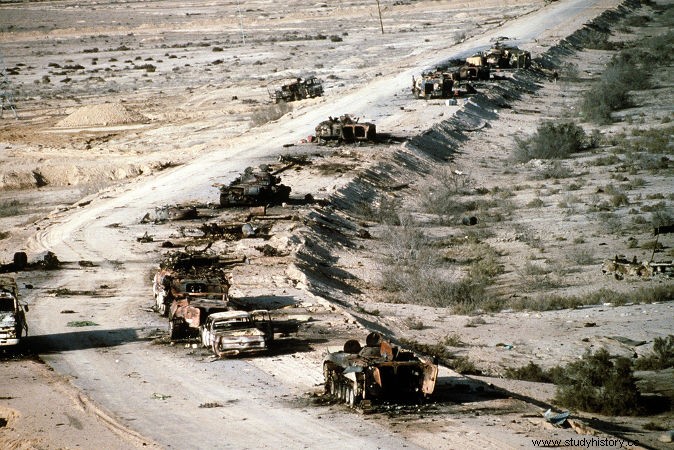
The Gulf War was a conflict that took place between the United States (leading international forces) against Iraq in early 1991. The American attack was a consequence of the invasion of Kuwait by the Iraqi army in 1990. This war became internationally known because of the images of the conflict that were broadcast in real time by the US television network.
Causes of the Gulf War
Iraq's invasion of Kuwait was a consequence of the Iraqi government's dissatisfaction with certain actions of the Kuwaiti government. To understand the reasons that led the United States to attack Iraq, it is first necessary to understand the reasons that led Iraq to invade Kuwait on August 2, 1990.
The context of the invasion of Kuwait on the date quoted dates back to the 1980s events related to the Iran-Iraq War . This conflict was fought between the two nations between 1980 and 1988, and Iraq's attack on Iran was part of international interests, which used Iraq as an instrument to stop the advance of the Islamic Revolution, what had happened in Iran in 1979.
During this war, the Iraqis had the support of the United States (the main interest in weakening Iran) and Saudi Arabia and Kuwait (they lent large sums of money to the country ruled by Saddam Hussein ). This broad international support prevented the Iraqis from being defeated, and the war ended in a status quo ante bellum , that is, in a tie.
It turns out that, after the war, the Iraqi economy was in crisis and it was necessary to increase the country's revenue. Iraq's biggest source of income was oil sales , however, the value of a barrel was considered low by the Iraqi government. In January 1990, a barrel of oil was sold at 21 dollars. In the middle of the same year, a barrel was already sold at 11 dollars.
The Iraqi government accused the Kuwaiti government of being largely responsible for reducing the value of a barrel for selling (and extracting) oil above the quotas established by the Organization of Exporting Countries of Oil (OPEC). In addition, the Iraqi government accused Kuwait of extracting oil from wells very close to the border between the two countries.
However, the factor that deeply irritated Saddam Hussein about Kuwait was the fact that the Kuwaiti began to demand the repayment of loans granted during the years of the Iran- Iraq. Saddam Hussein found this unacceptable, as he believed that Iraq's war effort against Iran had also served Kuwait's interests.
In view of these factors, Saddam Hussein developed a hostile discourse towards Kuwait. The Iraqi dictator defended the idea that the small neighboring nation was “historically Iraqi territory” and that it should be the 19th province of Iraq. The invasion of Kuwait started on August 2, 1990.
The decision of Saddam Hussein is seen by historians as a strategic mistake, because the Iraqi government had not considered that the United States would never allow the strengthening of a country that could threaten the sovereignty of the Saudi Arabia, America's great ally in the Middle East. Furthermore, the invasion of Kuwait would make Iraq one of the countries with the largest oil reserves in the world, something that would also not receive the American endorsement.
Consequences
After invading Kuwait, Iraqi forces quickly conquered the country, mainly because the Iraqi army was one of the largest in the world (because of the years of war with Iran). With the invasion, the Kuwaiti royal family was forced to flee and settle in Riyadh, the capital of Saudi Arabia.
The invasion of Kuwait generated an immediate international reaction, and on the same day as the invasion, the UN Security Council issued Resolution 660, which condemned the Iraqi-coordinated invasion and ordered Iraqi troops to leave Kuwait immediately. The continuation of Iraqi forces in Kuwait resulted in the landing of American and British troops in Saudi Arabia.
The American and British troops stationed in Saudi Arabia were purposefully deployed to prevent a possible invasion of that country by Iraqi troops. On November 29, 1990, the UN Security Council issued a new resolution against Iraq (Resolution 678 ). In this, the UN established that the Iraqi troops withdrew from Kuwait until January 15, 1991.
As the Iraqi government continued to ignore the UN Security Council's determinations, an international coalition led by the United States decided to act. From January 17, 1991, air attacks were initiated against Iraq. The attacks targeted strategic locations and spanned 42 days .
The images of the airstrikes became internationally known because they were broadcast in real time by the US television network. The attacks hit strategic locations used by the Iraqi army, such as weapons production sites, Iraqi army command centers, communications infrastructure, etc.
The air campaign was replaced by a ground campaign, which began on February 24, 1991. The international forces were led by US General Norman Schwarzkopf, and the military action by land lasted for 100 hours . Because of their unpreparedness, the Iraqi army was quickly defeated. From there, he began an escape, returning to Iraqi territory.
The last Iraqi troops left Kuwait on February 28, 1991, and on that same day, the United States ended the military offensive and the Gulf War. The US government's action antagonized those who expected the country to drive its troops into Iraqi soil with the aim of overthrowing Saddam Hussein - but that didn't happen until twelve years later.
The Gulf War of 1990-1991 is seen by some scholars as the first part of a conflict between the United States and Iraq, and the 2003 invasion is seen as a second part. These scholars classify the wars as First (1990-1991) and Second (2003) Gulf War. Other scholars disagree with this classification, arguing that the causes of both wars were completely separate and unconnected.
Take the opportunity to check out our video lesson on the subject:
